BWV 11, the oratorio which Bach wrote for Ascension Day (1 May this year) was probably first performed on 19 May 1735, putting it towards the end of his long association with the cantata form. There's not much that differentiates this 'oratorio' with a cantata, apart from the alotting of an Evangelist role to the tenor recitatives. Like the other late oratorios (for Christmas and Easter), Bach turned to previously existing music and parodied it with words appropriate to the new context. It never ceases to amaze me how successful he was at this!
It's a delightful work, with two wonderfully exuberant choruses, with trumpets and timpani, at the beginning and end and two exceptional arias, one for alto and one for soprano. The alto aria, taken from a now lost sacred cantata, was again reworked for the Agnus Dei of Bach's B Minor Mass.
And of the six recordings I've accumulated over the years, I enjoyed every one. To my ears there really is nothing between them and even better than this, they explore different aspects of the work and present a nice variety of interpretations. It seems as if I might be over-generous here, if you see the passions arising (often in opprobrium) on the Bach cantatas website. I must say, I never really approach music in search of some ideal of perfection and would rather take an overview than focus on the minutiae. So maybe that's why I can recommend each of the versions I've listened to over the last few days.
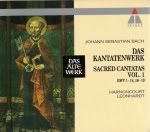 The earliest I have is from the groundbreaking complete cantata cycle of Nikolaus Harnoncourt and Gustav Leonhardt. On this occasion, it's Harnoncourt who leads the musicians. I love listening to these early period instrument recordings, not least because there's an energy, an 'edginess', about the performance which is just the sort of thing I like. The decision of Harnoncourt and Leonhardt to perform with all male singers, including boy sopranos, is one of the many things that makes their set unique. Some people find it difficult to accept this, as you do not get the same level of expertise compared to the very talented adult female sopranos others employ. It's not something that bothers me, I have to say, and I think they gained more from using boys' voices as instruments than they lost in terms of virtuoso fireworks. Here, the soprano is fine and alto Paul Esswood is also very good in his aria, although if I'm going to nitpick I preferred Michael Chance for Gardiner when it comes to male voices. But there's just something special about this overall performance, about the sound they achieve and the driven aesthetic, that makes any attempt to single out individual parts a bit pointless. It's one I keep returning to, with great pleasure.
The earliest I have is from the groundbreaking complete cantata cycle of Nikolaus Harnoncourt and Gustav Leonhardt. On this occasion, it's Harnoncourt who leads the musicians. I love listening to these early period instrument recordings, not least because there's an energy, an 'edginess', about the performance which is just the sort of thing I like. The decision of Harnoncourt and Leonhardt to perform with all male singers, including boy sopranos, is one of the many things that makes their set unique. Some people find it difficult to accept this, as you do not get the same level of expertise compared to the very talented adult female sopranos others employ. It's not something that bothers me, I have to say, and I think they gained more from using boys' voices as instruments than they lost in terms of virtuoso fireworks. Here, the soprano is fine and alto Paul Esswood is also very good in his aria, although if I'm going to nitpick I preferred Michael Chance for Gardiner when it comes to male voices. But there's just something special about this overall performance, about the sound they achieve and the driven aesthetic, that makes any attempt to single out individual parts a bit pointless. It's one I keep returning to, with great pleasure.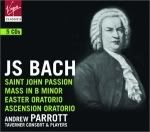 On a few years (1989) for a very different version from Andrew Parrott and the Taverner Consort and Players. This follows the groundbreaking research of Joshua Rifkin and Parrott himself which claims that Bach's usual performance practice was to employ a 'choir' made up of soloists singing one voice per part. There is a lithe beauty to this recording which this approach allows, in which the parts are wonderfully clear. Emma Kirkby's singing of the soprano aria was my highlight of this version. Another point in its favour is that it's available as a super budget box set, including Parrott's Easter Oratorio, B Minor Mass and St John Passion. All are to the same high standard.
On a few years (1989) for a very different version from Andrew Parrott and the Taverner Consort and Players. This follows the groundbreaking research of Joshua Rifkin and Parrott himself which claims that Bach's usual performance practice was to employ a 'choir' made up of soloists singing one voice per part. There is a lithe beauty to this recording which this approach allows, in which the parts are wonderfully clear. Emma Kirkby's singing of the soprano aria was my highlight of this version. Another point in its favour is that it's available as a super budget box set, including Parrott's Easter Oratorio, B Minor Mass and St John Passion. All are to the same high standard.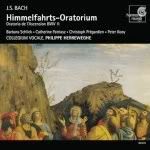 Philippe Herreweghe recorded the piece in 1993, employing a choir of four singers per part and four excellent soloists, one of the strongest I've listened to. There's a fullness to the sound and an integration of instruments and voices that conjurs up quite a spell. The opening and closing choruses are really successful in their sense of dancing exultation. Barbara Schlick is the pick of the soloists. Her voice doesn't seem to be to everyone's taste, but the combination of fragility and technique I find particularly effective in Bach's music. Alto Catherine Patriasz is also first rate in her performance, with Christoph Pregardien and Peter Kooy reliably good as Evangelist and bass respectively.
Philippe Herreweghe recorded the piece in 1993, employing a choir of four singers per part and four excellent soloists, one of the strongest I've listened to. There's a fullness to the sound and an integration of instruments and voices that conjurs up quite a spell. The opening and closing choruses are really successful in their sense of dancing exultation. Barbara Schlick is the pick of the soloists. Her voice doesn't seem to be to everyone's taste, but the combination of fragility and technique I find particularly effective in Bach's music. Alto Catherine Patriasz is also first rate in her performance, with Christoph Pregardien and Peter Kooy reliably good as Evangelist and bass respectively.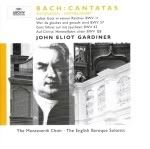 John Eliot Gardiner's version also dates from 1993 and this joyful music is something with which his Monteverdi Choir and English Baroque Soloists always seem to be able to rise to the challenge. He's at his strongest in the choruses which begin and end the piece, thrilling trumpets and singing driving the music forward. Michael Chance performs the alto aria very movingly, one of the best for me; Nancy Argenta brings a lovely pure tone to the soprano aria, accompanied by Gardiner's dancingly light touch. Anthony Rolfe-Johnson, who performed so well as Evangelist in Bach's major sacred works for Gardiner, is similarly good here and Stephen Varcoe also does well for what little the bass has to do. The rousing finale is Gardiner at his best.
John Eliot Gardiner's version also dates from 1993 and this joyful music is something with which his Monteverdi Choir and English Baroque Soloists always seem to be able to rise to the challenge. He's at his strongest in the choruses which begin and end the piece, thrilling trumpets and singing driving the music forward. Michael Chance performs the alto aria very movingly, one of the best for me; Nancy Argenta brings a lovely pure tone to the soprano aria, accompanied by Gardiner's dancingly light touch. Anthony Rolfe-Johnson, who performed so well as Evangelist in Bach's major sacred works for Gardiner, is similarly good here and Stephen Varcoe also does well for what little the bass has to do. The rousing finale is Gardiner at his best.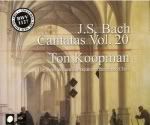 Ton Koopman included BWV 11 on Volume 20 of his complete cycle of Bach cantatas, the recording is from 2002 & 2003. Despite the fact that it was set down on two separate occasions, this is another tour de force and is probably, overall, my favourite of the six I've jotted about here. Alto Bogna Bartosz is the pick of the bunch when it comes to the alto aria and Koopman's organ accompaniment is full of flourishes that I particularly enjoyed. The other soloists are equally impressive. Soprano Sandrine Piau's aria is beautifully poised, tenor James Gilchrist knits it all together and Klaus Mertens (for all that the bass isn't used very much) is as good as ever.
Ton Koopman included BWV 11 on Volume 20 of his complete cycle of Bach cantatas, the recording is from 2002 & 2003. Despite the fact that it was set down on two separate occasions, this is another tour de force and is probably, overall, my favourite of the six I've jotted about here. Alto Bogna Bartosz is the pick of the bunch when it comes to the alto aria and Koopman's organ accompaniment is full of flourishes that I particularly enjoyed. The other soloists are equally impressive. Soprano Sandrine Piau's aria is beautifully poised, tenor James Gilchrist knits it all together and Klaus Mertens (for all that the bass isn't used very much) is as good as ever.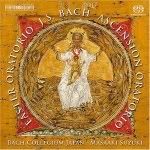 The most recent performance I've heard, by Masaaki Suzuki, was released in 2004 on a CD also containing the Easter Oratorio. All the music is performed to his usual high standard and his is a similarly impressive achievement to Koopman's. There's perhaps slightly fewer idiosyncratic touches with Suzuki; and the soloists, while excellent, were not quite at the same level as Bartosz for Koopman or Schlick for Herreweghe. I have to emphasise that this is just a personal response! Because these are very minor points - I'm beginning to think that it's impossible to perform this work in a disappointing way. Patrick van Coethem was possibly not as inspired as Chance in Gardiner's recording, but has a very good unforced tone, warm and full. Yukari Nonoshita can join the roster of wonderful soprano performances of the glorious aria. Tenor and bass are both very good, Jan Kobow in the Evangelist role particularly responsive to the texts.
The most recent performance I've heard, by Masaaki Suzuki, was released in 2004 on a CD also containing the Easter Oratorio. All the music is performed to his usual high standard and his is a similarly impressive achievement to Koopman's. There's perhaps slightly fewer idiosyncratic touches with Suzuki; and the soloists, while excellent, were not quite at the same level as Bartosz for Koopman or Schlick for Herreweghe. I have to emphasise that this is just a personal response! Because these are very minor points - I'm beginning to think that it's impossible to perform this work in a disappointing way. Patrick van Coethem was possibly not as inspired as Chance in Gardiner's recording, but has a very good unforced tone, warm and full. Yukari Nonoshita can join the roster of wonderful soprano performances of the glorious aria. Tenor and bass are both very good, Jan Kobow in the Evangelist role particularly responsive to the texts.Finally, I can only emphasise again that there is very little to choose between all of these versions and I can happily recommend all of them.
No comments:
Post a Comment